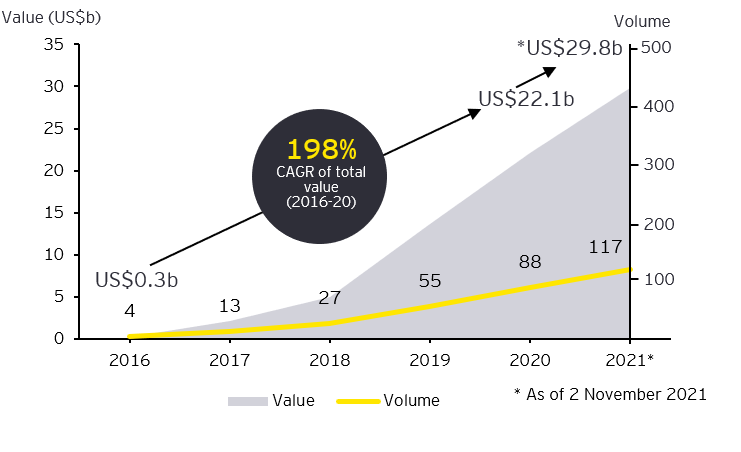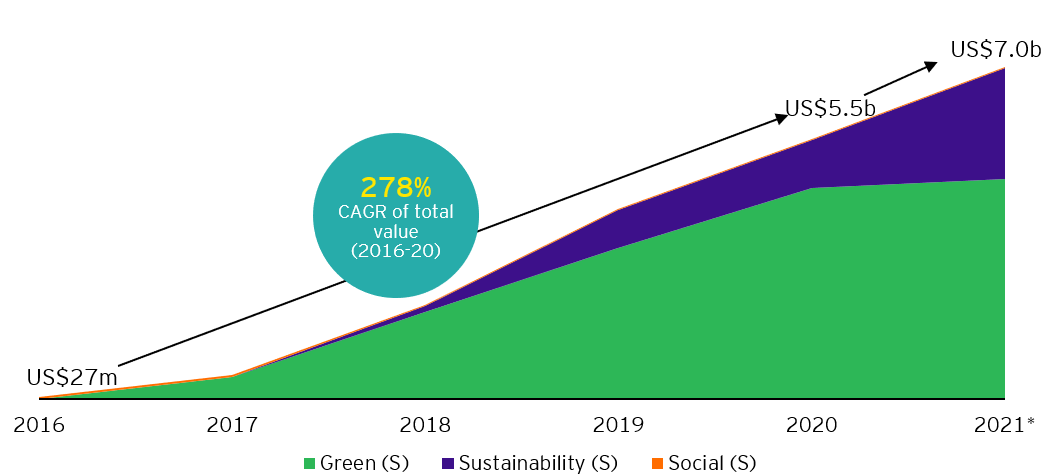EY refers to the global organization, and may refer to one or more, of the member firms of Ernst & Young Global Limited, each of which is a separate legal entity. Ernst & Young Global Limited, a UK company limited by guarantee, does not provide services to clients.

ASEAN6 markets are fast-tracking sustainable responsible investments (SRI) to yield positive impact and positive returns.
In brief
- ASEAN6 markets trending to SRI with exponential growth in sustainable bonds (185% CAGR) and sukuk (278% CAGR) over 2016-2020.
- The ASEAN6 commitment toward a low-carbon economy is well supported by the significant issuance of sustainability-themed investment products, and the development of environmental, social and governance (ESG) policies and regulations.
- Leading corporates and investors in the ASEAN6 markets have already begun reshaping their strategies to seize new investment opportunities in sustainable businesses and practices.
Prior to the COVID-19 pandemic outbreak, sustainable responsible investments (SRI) were already trending in global markets. SRI includes sustainable-themed investments which are focused on environmental, social and governance (ESG) or sustainable development goals (SDGs) and impact investing based on positive, measurable social and environmental impact in tandem with positive financial return.
There is a growing awareness among stakeholders, including institutional investors, financiers and regulators who are concerned about the impact of climate change and the material risks when deploying capital to their businesses and investments.
EY research, Trending: Sustainable responsible investment in Malaysia and the region highlight that the region is fast-tracking SRI in line with global trends. This positive investment trend is supported by the progressive ESG policy developments of the region, which will strengthen its commitment towards net zero carbon.
Key report highlights:
ASEAN6 markets trending to sustainable bonds and sukuk
The ASEAN6 markets, ranked 11th among global capital markets and valued over US$2.8 trillion in total market capitalization, is stepping up focus on SRI as a new investment area. In just five years, 2016 to 2020, the ASEAN6 markets recorded exponential growth of sustainable bonds and sukuk.
- Growth of sustainable bonds and sukuk issuances, at 198% CAGR, for the financing of projects aligned with ESG principles, and is estimated to have reached US$29.8 billion, as of November 2021.
- The sustainability-themed Shariah-compliant sukuk grew exponentially higher, at 278% CAGR, and is estimated to have reached US$7 billion, as of November 2021.
Growth trend of ASEAN6 sustainable bonds and sukuk, 2016 – 2021

ASEAN6 value of sustainable sukuk issuances, 2016-2021

ASEAN6 commitment to a low-carbon economy opens significant and new investment and business opportunities
While the maturity of the respective ASEAN6 markets vary, efforts by the policymakers of the ASEAN6 countries to progress ESG policies and formulate action plans are fostering the development of the low carbon economy and green-focused ecosystems. This would usher interest in investment and business opportunities for the region’s SRI growth, particularly for carbon-intensive companies who will require significant financing to help them transition to low carbon. Presently over two-thirds (68%) of the total ASEAN6 bonds and sukuk are focused on investments in three key sectors, namely energy (49%), green buildings (10%) and transportation (9%).
Meanwhile, EY 2021 Global Institutional Investor Survey reported 88% of respondents surveyed said they are likely to increasingly target green-focused investment opportunities following the COVID-19 pandemic, as they are seeking opportunities to be more resilient to climate change crises and provide sustainable long-term value. Looking ahead, the ASEAN green/low-carbon economy is estimated to provide potential annual business opportunities of nearly US$1 trillion by 2030.
Pertinent to note that the ASEAN region’s renewable energy sector is anticipated to garner an average investment of US$50 billion per annum from 2025-2030. The ASEAN Plan of Action for Energy Cooperation (APAEC) 2021-2025 targets renewable energy to constitute 23% of total primary energy supply, 35% installed power capacity by 2025; and the proposed target for fossil fuel investment to be reduced drastically from 37% to 2%.
ASEAN renewable energy investments

Growth drivers spurring ASEAN6’s sustainable investment growth prospects
The COVID-19 pandemic and regulatory focus on ESG has accelerated opportunities for ASEAN6 countries to build greener and more sustainable economies. In tandem, corporates and investors in the region are reshaping strategies to mitigate risks and explore new investment opportunities in sustainable businesses and practices.
Among the growth drivers propelling SRI development in the ASEAN6 markets include:
Corporates are moving into long-term ESG value propositions
Leading ASEAN6 corporates and organizations are developing ESG propositions to build their resilience and create long-term value. Business sectors, such as transport, energy and utilities, are considering low-carbon measures, investment in RE alternatives and adopting initiatives to reduce GHG emissions.
Investors are increasing their focus on corporates with leading ESG practices
The demand surge in ASEAN green, social and sustainable bonds highlight investors’ strong interest and marked shift toward financing projects with environmental and social benefits.
Regulators are progressing alignment with global policy developments on ESG and sustainability
ASEAN6 policymakers and regulators are formulating national roadmaps, blueprints, policies and action plans anchored on sustainability, climate change and low-carbon to catalyze sustainability initiatives among local businesses. ASEAN6 bourses have also issued sustainability reporting guidelines to complement the financial reporting for public-listed companies.
Consumer behaviors are driving ESG and sustainability practices
Regional consumer surveys highlight increasing consumer awareness on the impact of climate change and their trending preference to support and work for companies that care about and act on ESG issues. With the rising middle-class population in ASEAN6, from 33% of the total population in 2020 to the projected 50% by 2030, the adoption of ESG practices are likely to take-off.
Looking ahead, the progressive ESG policy developments of the ASEAN6 countries and their increasing commitment towards net zero carbon are fast-tracking the regional growth of sustainable responsible investment into the next decade.
About the publication:
Ernst & Young Consulting Sdn Bhd, Capital Markets Malaysia (CMM) and Sustainable Investment Platform (SIP) collaborated to produce this publication, “Trending: Sustainable responsible investment (SRI) in Malaysia and the region”. CMM was set up by Securities Commission Malaysia (SC) to spearhead the local and international positioning and profiling of the Malaysian capital market with its range of conventional and Islamic products, supported by a strong governance infrastructure. SIP was set up by CMM and Institutional Investors Council (IIC) to support institutional investor and the fund management industry in building the depth of SRI strategies which align financial returns with broader ESG priorities.
Download Trending: Sustainable responsible investment
Summary
In tandem with global market trends, ASEAN6 markets are advancing SRI as a new investment area. Over the recent five years (2016-2020), ASEAN markets recorded exponential 185% CAGR growth of sustainable bonds and sustainable sukuk at 278% CAGR. The heightened stakeholder focus on ESG among the ASEAN6 countries and their increasing commitment towards net zero carbon will drive the growth of sustainable responsible investment in the region, making ASEAN a long-term value proposition in the years ahead.
Related article
Is your ESG data unlocking long-term value?
Better environmental, social and governance (ESG) insight and data analytics could be critical to delivering long-term value. Find out more.



